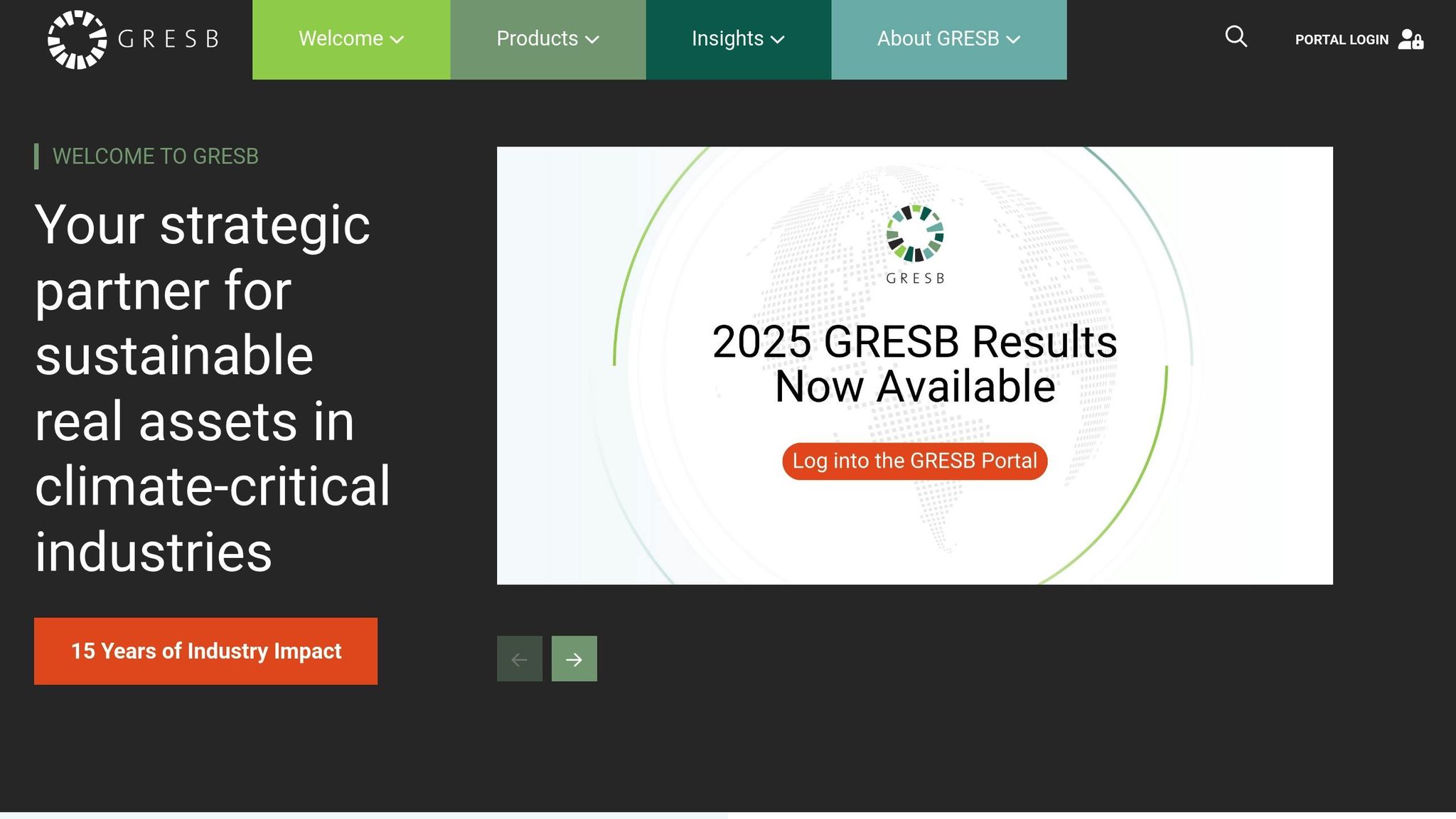GRESB Metrics for Portfolio Benchmarking
GRESB (Global Real Estate Sustainability Benchmark) provides a standardized framework for evaluating ESG (Environmental, Social, Governance) performance in real estate and infrastructure. With over $7 trillion in assets assessed annually, it’s a critical tool for real estate investors and managers aiming to measure sustainability and benchmark portfolios.
Key Takeaways:
- What GRESB Does: Scores portfolios (0-100) based on energy use, carbon emissions, governance, and tenant engagement, enabling performance comparisons.
- Why It Matters: Helps identify underperforming assets, attract investors, and align with regulatory requirements like SFDR.
- Challenges It Solves: Standardizes fragmented data, simplifies compliance, and offers actionable insights for portfolio improvement.
Tools Like CoreCast:

Platforms like CoreCast integrate GRESB metrics with other data, offering real-time insights, better decision-making, and automated reporting for portfolio managers.
Bottom Line: GRESB helps real estate professionals measure and improve sustainability performance, while tools like CoreCast enhance its usability for smarter investment management.
GRESB Metrics and Methodologies Explained

Key GRESB Metrics
GRESB evaluates three main areas: Environmental, Social, and Governance. The Environmental category looks at factors like energy use, emissions, water management, and waste. Social metrics focus on tenant engagement, health and safety, and community impact. Governance examines management structures, policies, and transparency. Each of these indicators is scored and weighted, creating a measurable sustainability profile that applies across different property types and regions [1].
This scoring system forms the foundation of the GRESB Benchmark Report, which allows for precise peer comparisons.
GRESB Benchmark Report
The GRESB Benchmark Report is a critical resource for tracking performance and comparing results within peer groups. For real estate, GRESB provides two specific benchmarks:
- GRESB Standing Investment Benchmark: Focuses on the Management and Performance Components.
- GRESB Development Benchmark: Concentrates on the Management and Development Components [1][2].
In 2024, more than 2,200 entities participated, representing a staggering US$7 trillion in assets and benchmarking over 200,000 properties across 80 markets [2]. The report’s detailed dataset, broken down into 15 sectors, allows portfolios to compare themselves to similar asset types, delivering meaningful insights.
Sector-Specific GRESB Components
GRESB has refined its framework to address the distinct needs of various real estate sectors. By customizing components for each asset type, the assessment ensures accurate benchmarking. This tailored approach supports the evaluation of US$7 trillion in Gross Asset Value (GAV) across 15 sectors in 80 markets [3]. These sector-specific metrics not only enhance portfolio comparisons but also provide actionable insights for improvement.
REAL talk: A deep dive into REAL Benchmarks | The Pulse by GRESB
How GRESB Metrics Solve Portfolio Benchmarking Problems
GRESB metrics tackle common portfolio benchmarking challenges by offering clear solutions through improved standardization, easier compliance, and actionable analytics.
Improved Data Quality and Standardization
One of the biggest hurdles in traditional portfolio benchmarking has been inconsistent data. Different property types, markets, and reporting methods made reliable comparisons nearly impossible. GRESB solves this by setting uniform data collection standards, ensuring consistency across the board.
With a standardized framework, GRESB allows property managers to make consistent comparisons, no matter the market. Their strict verification process and quality controls ensure that the data is dependable, giving investors confidence in their decisions. Plus, GRESB tailors its evaluation criteria to fit specific asset types, making the benchmarking process both practical and relevant.
Easier Regulatory Compliance and Investor Reporting
The growing demand for transparent ESG reporting, especially from institutional investors and regulatory bodies, has added significant pressure on real estate portfolios. Regulations like SFDR require sustainability reporting to be more streamlined and accessible.
GRESB assessments help portfolios meet these demands by providing comprehensive sustainability reports aligned with international standards. The GRESB Benchmark Report delivers ready-to-use data that satisfies investor due diligence needs, simplifying the reporting process for entities like pension funds and insurance companies managing diverse real estate investments.
Actionable Insights for Smarter Decision-Making
GRESB metrics go beyond just improving data quality and compliance - they also enable better decision-making. Instead of treating benchmarking as a once-a-year task, GRESB transforms it into an ongoing strategic tool. Its rich dataset provides real-time insights that help portfolio managers identify underperforming assets, evaluate potential acquisitions, and plan capital improvements.
For example, by comparing their scores with peers, managers can quickly spot performance gaps. If office buildings in a portfolio consistently fall short on energy efficiency, GRESB’s insights can guide targeted upgrades that boost both sustainability and property value.
These sector-specific benchmarks also allow managers to make more informed investment decisions. For instance, someone overseeing industrial properties can use peer comparisons to address the unique challenges of warehouses and distribution centers. By understanding where properties excel or lag, managers can refine acquisition strategies and allocate resources more effectively, ensuring the portfolio performs at its best.
sbb-itb-99d029f
Using GRESB Metrics with CoreCast for Complete Portfolio Intelligence
GRESB metrics are already a powerful tool for benchmarking in real estate, but their potential grows exponentially when integrated into a real estate intelligence platform like CoreCast. This combination transforms static, annual assessments into a dynamic, ongoing process that enhances portfolio management and drives smarter investment decisions. The result? A shift from periodic evaluations to continuous, actionable insights.
Why Integration Enhances Portfolio Benchmarking
Traditional benchmarking often relies on fragmented data sources, leading to inefficiencies and lost opportunities. Real estate professionals frequently spend valuable time piecing together various data sets to get a clear picture of portfolio performance. This disjointed approach not only slows down the process but also increases the chances of errors.
By integrating GRESB metrics into a single platform, these challenges are resolved. CoreCast consolidates sustainability benchmarks, financial data, market trends, and operational performance into one cohesive system. This integration provides real-time insights, enabling portfolio managers to adapt quickly to changing conditions. The result is a more efficient and accurate approach to benchmarking that drives better outcomes.
CoreCast Features Supporting GRESB Metrics
CoreCast takes GRESB data to the next level by turning it into actionable intelligence. The platform’s capabilities are designed to maximize the value of GRESB benchmarking data while streamlining key processes:
- Underwriting and Pipeline Tracking: CoreCast integrates GRESB insights into its acquisition tools, helping portfolio managers evaluate how potential investments will impact overall GRESB scores and sustainability goals.
- Geographic Mapping: The platform’s mapping feature visualizes GRESB data across a portfolio, making it easy to spot regional trends, understand market dynamics, and prioritize improvements in specific areas.
- Detailed Portfolio Analysis: Instead of just flagging deficiencies in sustainability metrics, CoreCast allows managers to pinpoint underperforming properties, identify improvement opportunities, and assess the financial and GRESB score impact of proposed changes.
- Stakeholder Communication: CoreCast simplifies the reporting process with tools that combine GRESB data, financial metrics, and strategic insights into professional, branded reports. These reports are tailored to meet the expectations of investors, lenders, and other stakeholders.
Benefits of an Integrated Real Estate Intelligence Platform
Bringing GRESB benchmarking into a unified platform like CoreCast delivers benefits that go far beyond convenience. With all data housed in one system, portfolio managers gain a holistic view of performance, making it easier to spot patterns and correlations that might otherwise go unnoticed.
This integrated approach also saves time and reduces costs. Instead of spending weeks each quarter gathering data, reconciling discrepancies, and creating reports, portfolio managers can access real-time dashboards that automatically incorporate the latest GRESB metrics alongside other key data points. This efficiency allows teams to focus on strategy - analyzing market trends, planning improvements, and engaging with stakeholders - rather than getting bogged down in data management.
Data accuracy and consistency improve as well. When GRESB metrics are seamlessly integrated with financial analysis, market research, and reporting tools, the risk of errors from manual data entry or outdated information is significantly reduced.
Finally, the platform provides a robust audit trail, documenting every decision, assumption, and data point. This transparency not only satisfies regulatory requirements but also builds trust with institutional investors, who increasingly demand detailed, traceable insights from real estate managers.
Conclusion: Improving Portfolio Performance with GRESB and CoreCast
In today’s competitive and regulated market, sustainability metrics are no longer optional - they’re a critical part of staying ahead. GRESB provides a reliable framework for measuring and benchmarking sustainability, while CoreCast takes it a step further by turning those metrics into actionable insights that drive smarter portfolio management.
Why GRESB Matters for Portfolio Benchmarking
GRESB metrics solve a long-standing challenge in portfolio benchmarking: inconsistency. By standardizing the data collection process, GRESB ensures that performance is measured in a uniform way, no matter how diverse the portfolio. This is especially important for managers overseeing properties across different markets, asset classes, or regions.
With this consistency, portfolio managers can confidently set realistic improvement goals for various assets. It becomes easier to pinpoint underperforming properties, knowing the comparisons are based on trusted, industry-approved standards. Additionally, aligning operational performance with GRESB criteria helps managers meet investor expectations while strengthening their strategic positioning.
CoreCast: Elevating Real Estate Intelligence
While GRESB lays the groundwork for benchmarking, CoreCast takes those insights to the next level. It integrates GRESB’s sustainability data into a broader portfolio intelligence framework, ensuring that these metrics inform every stage of the investment process - from underwriting to asset management to stakeholder reporting.
CoreCast enables real-time monitoring and decision-making, allowing managers to adapt strategies based on emerging trends and demonstrate measurable progress. This proactive approach benefits both operators and investors by turning static data into dynamic, actionable plans.
Moreover, CoreCast seamlessly combines sustainability metrics with financial analysis, offering a comprehensive view of portfolio performance. By examining GRESB scores alongside market conditions, competitive positioning, and financial results, managers gain the clarity needed to allocate capital wisely, prioritize asset improvements, and refine their overall strategy.
The platform’s automated reporting tools ensure that communication with stakeholders remains clear and professional, even as portfolios grow more complex. This consistency is vital for maintaining strong relationships with diverse investor groups, each with unique reporting needs and ESG priorities.
For real estate professionals aiming to optimize portfolio performance, the synergy between GRESB and CoreCast is a game-changer. Together, they provide a complete toolkit for navigating the sustainability-driven real estate landscape, empowering managers to make informed, value-driven decisions that set their portfolios up for long-term success.
FAQs
How does GRESB scoring help real estate managers identify and address underperforming assets?
GRESB's scoring system gives real estate managers a clear view of how their assets are performing by analyzing key performance indicators across their portfolios. It flags irregularities like unexpected energy or water usage, deviations from sustainability standards, or operational inefficiencies.
With its detailed, data-driven insights, the system helps managers zero in on specific assets that need attention. This enables them to take focused actions to improve sustainability, streamline operations, and boost overall portfolio performance.
How does integrating GRESB metrics with CoreCast improve portfolio management decisions?
Integrating GRESB metrics with CoreCast gives portfolio managers detailed ESG insights to guide smarter, more responsible investment choices. By comparing portfolios to industry benchmarks, managers can spot performance gaps, monitor progress over time, and focus on areas that need attention.
This integration makes data collection and analysis easier and more accurate by cutting down on manual work. With real-time insights and smoother workflows, managers can improve portfolio performance, strengthen risk management, and stay aligned with changing ESG standards - all from one centralized platform.
How does GRESB help real estate investors and managers overcome challenges in ESG reporting and compliance?
GRESB provides real estate investors and managers with a clear framework to evaluate and compare sustainability performance, simplifying ESG reporting and compliance. By standardizing the process, it ensures consistent and reliable data across entire portfolios, making it easier to monitor progress and pinpoint areas that need attention.
Beyond that, GRESB helps tackle the challenges of shifting ESG regulations by encouraging openness and aligning with regulatory expectations. By collecting key ESG metrics, it equips stakeholders to better manage risks, strengthen sustainability initiatives, and make well-informed decisions to meet compliance goals.

